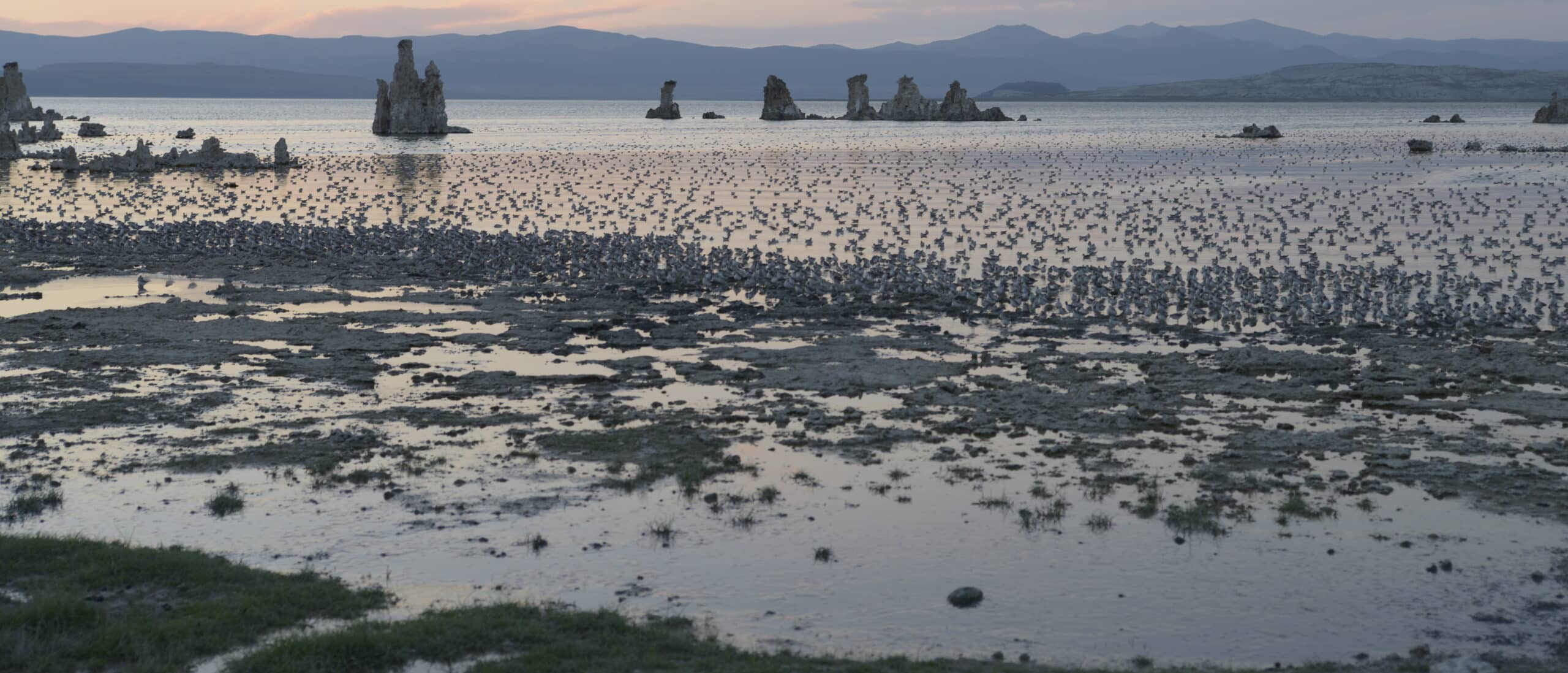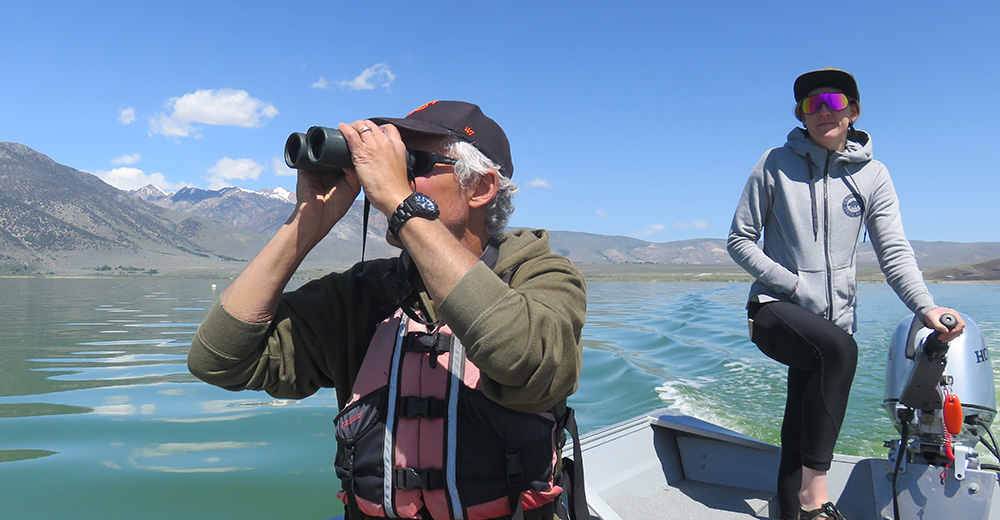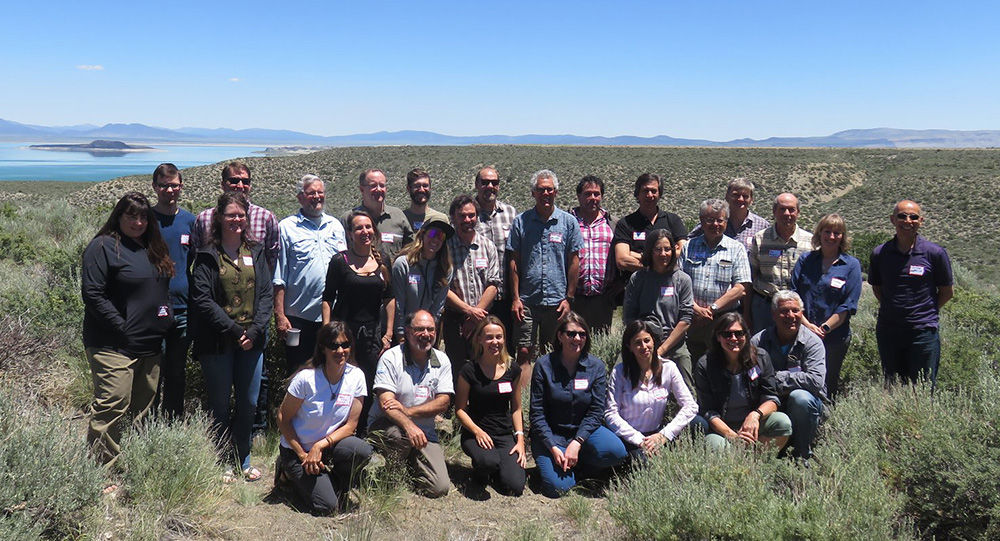
If you’ve been to Mono Lake in late July, you may have been lucky enough to have seen the elegant aerial ballet of a flock of Wilson’s Phalaropes.

This summer there were thousands of phalaropes along Mono Lake’s south shore, so visitors were fortunate to have the chance to witness these small shorebirds in magnificent flocks dancing above the reflective lake surface, turning on a dime, flashing their white bellies all at once before seeming to disappear in the dark mountain background when they turn their brown and gray backs in unison. This flocking behavior is a truly breathtaking sight to behold. It was a notable phalarope summer at Mono Lake in several other ways as well.
Inaugural phalarope meeting
In June, an international group of researchers, land managers, and conservationists came together at Mono Lake to share knowledge and ideas about global phalarope conservation and saline lake management. Ryan Carle of the non-profit Oikonos Ecosystem Knowledge and Dr. Margaret Rubega of the University of Connecticut hosted 30 attendees representing 15 agencies and organizations (including the Mono Lake Committee) from Argentina, Chile, Paraguay, Peru, and the US—countries along phalarope migration routes. The meeting helped clarify specific threats to phalarope habitat and migration routes, identify gaps in existing phalarope data, and culminated in the formation of a Phalarope Working Group that will continue to meet and share information going forward. The meeting comes at a key juncture for phalaropes as interested parties are trying to gauge the conservation status and distribution of these birds amid growing concern over their numbers and the decline of many saline lakes in North and South America, which are critical habitat for phalarope migration.

Research resumes
This summer, Carle and Dr. Rubega resumed transect surveys on Mono Lake to count Wilson’s and Red-necked phalaropes, carrying on Dr. Rubega’s work from the early 1990s and 2017. Phalarope research at Mono Lake has been sporadic and used differing methods—the Mono Basin Research Group, which did the first counts in 1976, surveyed the birds by bicycle, canoe, and on foot. Subsequent studies used more replicable survey methods that covered more of the lake area. These studies found significant fluctuations in the numbers of Wilson’s Phalaropes at Mono Lake, ranging from 1,000 birds in 1992 to 93,000 birds in 1976. This year’s counts totaled approximately 11,000 birds. Researchers have observed that the numbers of phalaropes that visit the Great Salt Lake in Utah also fluctuate greatly year to year, with 90,000 counted in some years and 600,000 counted in others. More data is needed to explain these fluctuations at both lakes.
The researchers from the international phalarope meeting proposed tagging individual phalaropes on their breeding grounds with miniscule VHF transmitters and tracking them using the Motus Wildlife Tracking System. When tagged animals and insects are in close proximity to a Motus tracking station, it sends data to researchers that can show patterns of species movement, improve population estimates, and fill in many data gaps. The Committee is working to secure funding to help include the Mono Basin in the tracking station network initiative. As there are currently no stations in the Great Basin, this will push Mono Lake to the forefront of research once again.
A hemispheric scientific community
This great collective effort speaks volumes about the rich scientific community that cares about Mono Lake and its bird populations. The Committee supported the meeting and thanks the Sierra District of California State Parks and the Mono Basin Bird Chautauqua’s Jeff Maurer Research Grant for funding this year’s surveys at Mono Lake; Ryan Carle and Dr. Margaret Rubega for organizing the phalarope meeting; the Robert & Patricia Switzer Foundation, US Forest Service International Program, Los Angeles Department of Water & Power, and Manomet for funding and sponsoring the meeting; and Aves Argentinas and Argentina Natura International for their effort to establish the largest National Park in Argentina at Laguna Mar Chiquita, the winter home to large concentrations of Wilson’s Phalaropes.
Getting a Motus tracking station installed at Mono Lake will contribute to local and global phalarope research. If you are interested in helping fund a tracking station for the Mono Basin, please contact Philanthropy Director Anna Christensen at (760) 647-6595.
This post was also published as an article in the Fall 2019 Mono Lake Newsletter (pages 6 & 27).
